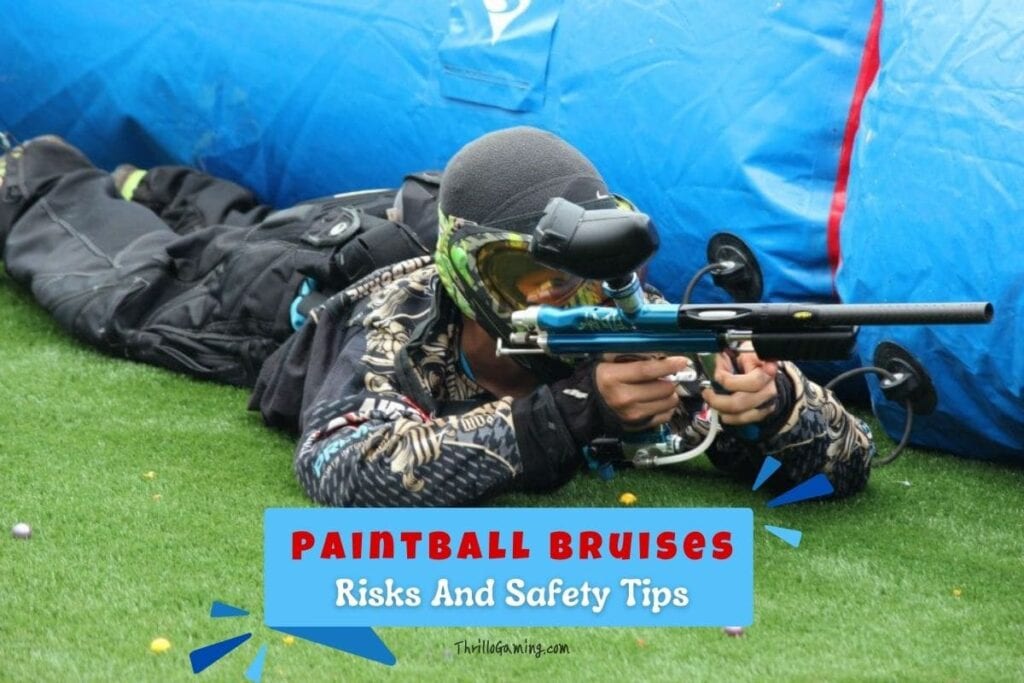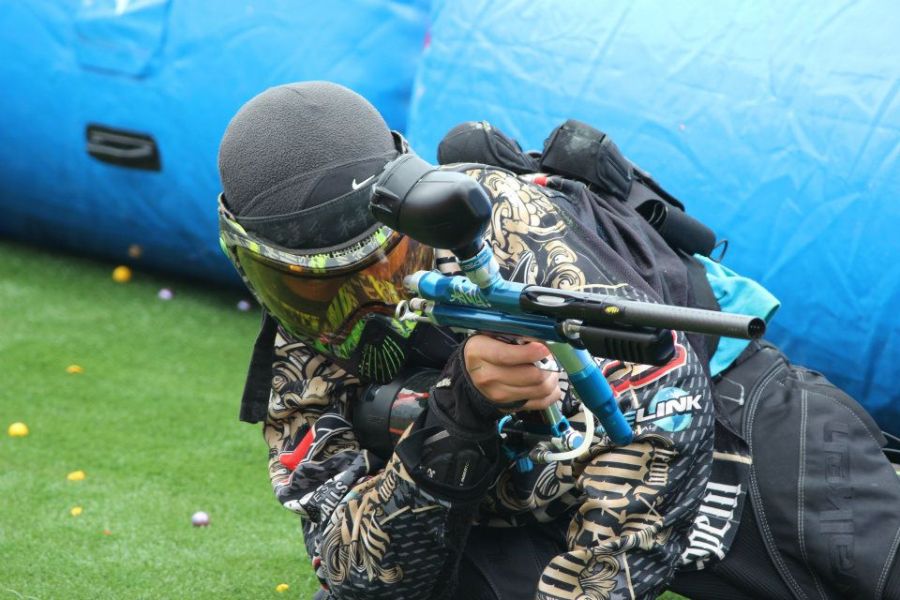Every year, hundreds of police reports are filed in the United States due to paintball injuries- mainly welts or bruises. In most cases, the victims are non-participants or outsiders with NO PROTECTIVE GEAR. However, in response to the increasing number of incidents, some state police have issued serious warnings to players and organizers.
In some areas, paintball markers have been classified as ‘firearms’, empowering the administration to clamp down on social media reels or prank videos that may cause harm to passers-by.
While paintball is a SAFE game inside the arena, participating without proper protective gear can lead to injuries such as bruises. The risk of bleeding is minimal, except in some soft and sensitive areas of the body.

How Nasty Can Bruises From Paintball Be?
You can’t master any outdoor action sports without more or less pain— true from paintball to airsoft. In my early career, I didn’t know how to stay safe and got hit by paint balls a few times with ring-like bruises on my back and thigh.
Paintball injuries can vary in severity, but in my observation, they are not too dangerous as long as they don’t hit your eyes. Those wounds are caused by the momentum of the balls hitting the skin, and it typically results in red or purple coloration and tenderness around the affected area.
The seriousness of a bruise can depend on various factors. This includes the distance from which the ball was shot, the velocity of the shot, the hardness of its outer shell, and whether the player is wearing enough protective gear.
However, in sensitive or unprotected areas of the body, such as the face, neck, and groin, bruises from paintball are usually more noticeable (like welts) and cause more discomfort. Ballers need to wear appropriate protective clothing, including a full-face mask and padded clothing, to minimize the risk of getting hurt.
While bruising is common among beginners, serious injuries are relatively rare when safety guidelines and equipment are properly utilized. If you experience persistent pain, swelling, or any unusual symptoms after playing paintball, it’s advisable to seek medical attention to ensure proper evaluation and treatment.
Here is an interesting video by Matt Davies, in which he experiments with paintball bruises using pellets of different sizes. (Please note: Do not attempt this on your own; Matt is a professional.)
Are Paintball Bruises Different From Welts?
Yes, bruises and welts are related but distinct outcomes of getting hit by a paint ball. Both are caused by the impact of the pellet, but they exhibit some differences in appearance, severity, and sensation.
A bruise (or contusion) is a form of paintball injury that happens when small blood vessels near the thin skin’s surface are blocked and allow blood to spread into the surrounding tissue. This causes the skin to darken and become painful with minimum touch.
On the other hand, a welt is a raised or little fluffy (swollen skin/ red bumps/ red circle on skin) structure that develops due to an inflammatory response to a direct hit.
Here is a comparison table to help you understand their differences:
| Point of Difference | Paintball Bruises | Paintball Welts |
|---|---|---|
| Appearance | Typically, paintball bruises are found as discoloration on the skin, appearing as red or purple marks. | Welts are raised, red, and swollen marks on the skin. They are more pronounced than typical bruises and can be more visible. |
| Sensation | Those are characterized by tenderness around the affected area. The discomfort is often a result of the impact but is generally temporary. | It may cause more immediate discomfort compared to bruises due to the swelling and raised nature of the affected skin. |
| Severity | Most bruises from paintball are minor and heal on their own over time. They are usually not considered extremely harmful. | While paintball welts are generally not dangerous, they can be more noticeable and potentially more uncomfortable than usual bruises. |
So, How To Treat Paintball Bruises?
While I am not a medical professional and cannot provide treatment guidance, I have witnessed numerous paintball games involving hundreds of players, including myself, in different arenas over the last decade. Most bruises were minor and could be managed with first aid, but some required immediate attention from a doctor.
Having witnessed the processes firsthand and listened to the doctors, I personally adhere to these immediate guidelines for managing paintball injuries before seeking medical attention (if needed). Just follow these steps-
- Wash the affected area properly with mild soap and water to remove dust, dirt, or paint residue. I have seen my team members use rubbing alcohol/ iodine solution to clean the bruise; after that, they leave it to dry or apply a microfiber towel or napkin to soak it.
- To reduce swelling and pain, apply an ice pack to the affected area. Wrap the ice in a clean cloth or towel to prevent direct contact with your skin, and apply it for 10 minutes at a time. While some recommend alternating hot and cold treatments, I’ve observed that paintballers are more comfortable with ice packs.
- Painkillers aid in alleviating pain and reducing swelling of wounds. Personally, as a precaution for emergencies, I’ve begun carrying over-the-counter painkillers like ibuprofen in my backpack, following my doctor’s advice. Thankfully, I haven’t had to use them to date!
However, if you have a welt or the injury is more complicated, I strongly recommend seeking advice from a medical professional before attempting the above steps, as the approach may vary depending on the severity.
But, How Long Do The Bruises Last?
Everyone’s healing and immunity processes are unique. Paintball bruises, often resembling welts, can last for varying duration, influenced by the intensity of the injury and an individual’s recovery mechanism. Typically, most injuries fade within a few days and should completely heal from a few days to a few weeks.
However, in the case of severe welts, the healing process may extend, and visibility might persist for several weeks. In rare situations, they may even darken (or bleed) from purple before eventually disappearing.
This can vary based on factors such as the severity of the impact, individual healing processes, and the use of protective gear. In most cases:
Minor Bruises: Injuries that are not too severe typically last for a few days to a week. The discoloration may change from red or purple to green or yellow as the body gradually recovers the damaged blood vessels.
Moderate Bruises: If the impact was more intense, it might take up to two weeks for the wound to fade and heal. During this time, the discomfort and tenderness should gradually diminish.
Severe Bruises or Welts: In cases where the bruise is more significant or if a welt has formed, the healing process may take longer, possibly extending beyond two weeks.
Keep in mind that individual responses to bruises can vary, and the healing process may be quicker or slower for some people than for others.
What To Do If The Wound Doesn’t Go Away?
If a bruise from paintball fails to disappear or worsens despite previous efforts, seeking medical assistance is crucial. While in most cases, it typically resolves on its own within a few weeks, persistent bruising may indicate a more SERIOUS INJURY.
Avoid scratching the bruise, as it can cause additional skin damage and impede the recovery process. Resting and elevating the affected area may help reduce swelling and facilitate recovery, so it’s advisable to refrain from any physical activities that could exacerbate the injury.
A medical professional can assess the wounds and offer guidance on the treatment. Recently, there has been a breakthrough in bruise detection, thanks to ‘Paintball Lady’ Katherine Scafide, Ph.D., a former forensic nurse examiner, and current assistant professor at George Mason University.
Tips To Prevent Getting Bruises From Paint Balls
To minimize the risk of severe bruises and welts, it’s crucial to wear long-sleeved attire (consider a double layer if possible) or protective gear, adhere to the game’s rules and guidelines, and approach play with caution and respect for fellow participants.
Nevertheless, here’s a concise overview of tips to avoid bruising when playing paintball:
1. Use Protective Gear
The most crucial measure to avoid bruises is wearing proper protective clothing, including a full-face mask, long-sleeved shirts, comfortable pants, and specialized shoes. Additionally, safety gear such as a padded vest, abdomen, and back protectors, neck guards, gloves, and a helmet can significantly contribute to preventing injuries.
As the typical speed of paint balls is around 250-300 fps, they can potentially cause eye damage upon direct impact, so it is imperative to always wear a mask. I recall an incident where a new player had his mask tilted halfway, resulting in a paintball wound near his eye. Fortunately, the ophthalmologist confirmed no significant effect on the eye.
Never remove the mask during the game under any circumstances, even if it’s smeared with paint or in adverse weather conditions like rain or fog. Carry tissue paper or napkins, exit the field, and then remove the mask for cleaning.

2. Layer Up Your Dress
When gearing up for a paintball match, prioritize protection by layering your clothing. Opting for thicker materials and incorporating additional padding provides an effective shield against the impact of paint-filled balls that lead to bruises.
This strategic approach not only minimizes the effect of hits but also helps distribute the force, reducing the risk of injuries and discomfort. Layering ensures a protective barrier, enhancing overall safety and allowing paintballers to fully enjoy the game with confidence.
3. Mind Your Distance
To minimize the risk of getting hit by paint balls at close range and having a welt, it is crucial to maintain a safe distance of 80-100 feet from your opponents. This precautionary measure ensures a balance between the thrill of the sport and the players’ well-being. Maintaining this distance mitigates the intensity of impact and also promotes a fair and enjoyable experience.
4. Play Strategically
Enhance your paintball experience by adopting strategic gameplay. Utilize cover effectively to minimize exposure to opponents, thereby increasing your chances of avoiding direct hits, leading to injuries. The key is thoughtful positioning—steer clear of unnecessary risks that might result in close, powerful shots from opponents.
Playing strategically boosts your chances of not getting a bruise and contributes to overall team success too. Implementing smart tactics, such as using cover and maintaining mindful positioning, will make you a better paintballer on the field.
5. Keep Moving In An Unpredictable Way
Maintain quick mobility, employing an ambush attack strategy, to avoid becoming an easy target. This not only makes it more challenging for your opponents to hit you with pellets but also helps minimize the impact of a hit due to the acceleration of your movement.
6. Adjust The Shooting Speed Of Your Paintball Gun
It’s crucial to maintain a standard speed of paintballs to minimize the risk of causing bruises during the match. Higher velocities compromise player safety and intensify the impact of pellets.
You can easily adjust the shooting speed using one of the best paintball guns to match the game rules. In most arenas, the maximum speed limit for a marker is 300 FPS— not too fast, not too slow.
Adhering to field regulations ensures a level playing field while fostering a secure environment for all participants. By moderating the marker velocity, you contribute to a more engaging experience, balancing the excitement of the sport and the well-being of participants.
7. Communicate With Teammates
I always collaborate with my teammates to develop strategies aimed at minimizing direct hits and maximizing the effectiveness of my team’s efforts. So, effective coordination is crucial—communicate your position to prevent instances of friendly fire.
What’s more? It reduces the chance of bad injuries and cultivates strategic planning. Sharing information and working together create a synergistic approach, enabling your team to outsmart opponents on the paintball field.
The Takeaway
Playing paintball might result in some injuries as the high-speed (250-300 fps) balls hit your ‘bare’ skin with full momentum. Using suitable protective gear, such as a helmet, gloves, and padding, can reduce the chance of bruising or welts- a PROVEN METHOD for me.
Furthermore, ballers must adhere to the game’s rules and regulations, such as avoiding close-range shooting (maintaining minimum distance) and aiming at non-sensitive areas of the body.
When lacking protective gear, avoid targeting the face or abdomen. It’s crucial to refrain from targeting outsiders or individuals without protective gear, as doing so may lead to legal consequences.
By following these basic measures, the risks associated with playing paintball can be significantly reduced, making the outdoor sport safe and enjoyable for participants of all skill levels.

